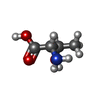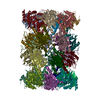+Search query
-Structure paper
| Title | Optimization of α-amido boronic acids via cryo-electron microscopy analysis: Discovery of a novel highly selective immunoproteasome subunit LMP7 (β5i)/LMP2 (β1i) dual inhibitor. |
|---|---|
| Journal, issue, pages | Bioorg Med Chem, Vol. 109, Page 117790, Year 2024 |
| Publish date | Jul 15, 2024 |
 Authors Authors | Yuuki Arai / Hiroaki Shitama / Masahito Yamagishi / Satoshi Ono / Akiko Kashima / Masahiro Hiraizumi / Naoki Tsuda / Koushirou Katayama / Kouji Tanaka / Yuzo Koda / Sayuka Kato / Kei Sakata / Osamu Nureki / Hiroshi Miyazaki /  |
| PubMed Abstract | The immunoproteasome subunit LMP7 (β5i)/LMP2 (β1i) dual blockade has been reported to suppress B cell differentiation and activation, suggesting that the dual inhibition of LMP7/LMP2 is a promising ...The immunoproteasome subunit LMP7 (β5i)/LMP2 (β1i) dual blockade has been reported to suppress B cell differentiation and activation, suggesting that the dual inhibition of LMP7/LMP2 is a promising approach for treating autoimmune diseases. In contrast, the inhibition of the constitutive proteasome subunit β5c correlates with cytotoxicity against non-immune cells. Therefore, LMP7/LMP2 dual inhibitors with high selectivity over β5c may be desirable for treating autoimmune diseases. In this study, we present the optimization and discovery of α-amido boronic acids using cryo-electron microscopy (cryo-EM). The exploitation of structural differences between the proteasome subunits led to the identification of a highly selective LMP7/LMP2 dual inhibitor 19. Molecular dynamics simulation based on cryo-EM structures of the proteasome subunits complexed with 19 explained the inhibitory activity profile. In mice immunized with 4-hydroxy-3-nitrophenylacetyl conjugated to ovalbumin, results indicate that 19 is orally bioavailable and shows promise as potential treatment for autoimmune diseases. |
 External links External links |  Bioorg Med Chem / Bioorg Med Chem /  PubMed:38906067 PubMed:38906067 |
| Methods | EM (single particle) |
| Resolution | 2.0 - 2.7 Å |
| Structure data | EMDB-39482, PDB-8ypk: EMDB-39565, PDB-8ysx: EMDB-39600, PDB-8yvg: EMDB-39612, PDB-8yvp: |
| Chemicals |  PDB-1l0c:  PDB-1l0d:  ChemComp-HOH:  ChemComp-THR: |
| Source |
|
 Keywords Keywords | HYDROLASE / Inhibitor / complex / Proteasome / Immunoproteasome |
 Movie
Movie Controller
Controller Structure viewers
Structure viewers About Yorodumi Papers
About Yorodumi Papers












